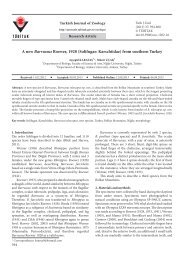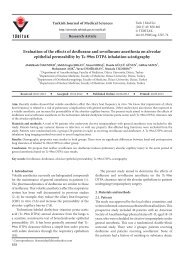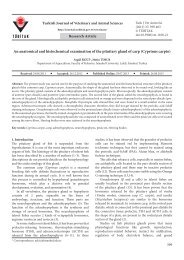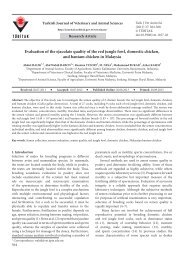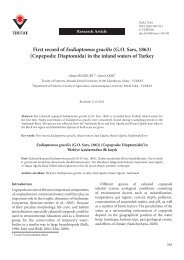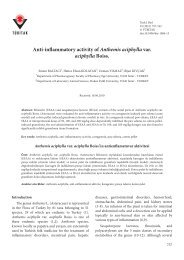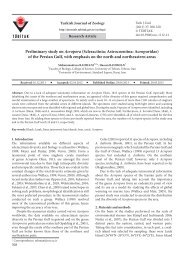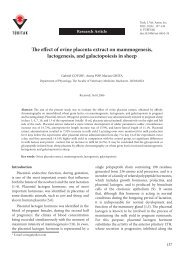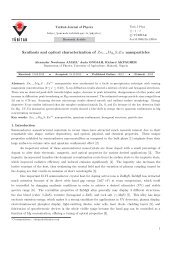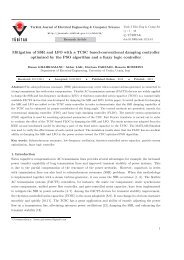The optimization of aDNA extraction protocol and sex determination ...
The optimization of aDNA extraction protocol and sex determination ...
The optimization of aDNA extraction protocol and sex determination ...
Create successful ePaper yourself
Turn your PDF publications into a flip-book with our unique Google optimized e-Paper software.
S. ARSLAN, A. AÇIKKOL, E. M. KORKMAZ<br />
Th e <strong>optimization</strong> <strong>of</strong> <strong>aDNA</strong> <strong>extraction</strong> <strong>protocol</strong> <strong>and</strong><br />
<strong>sex</strong> <strong>determination</strong> <strong>of</strong> Bronze Age individuals from<br />
Oylum Höyük (Kilis, Turkey)<br />
Turk J Biol<br />
35 (2011) 647-653<br />
© TÜBİTAK<br />
doi:10.3906/biy-1007-35<br />
Serdal ARSLAN 1 , Ayşen AÇIKKOL 2 , Ertan Mahir KORKMAZ 1<br />
1<br />
Department <strong>of</strong> Molecular Biology <strong>and</strong> Genetics, Faculty <strong>of</strong> Science, Cumhuriyet University, 58140 Sivas - TURKEY<br />
2<br />
Department <strong>of</strong> Anthropology, Faculty <strong>of</strong> Literature, Cumhuriyet University, 58140 Sivas - TURKEY<br />
Received: 19.07.2010<br />
Abstract: Oylum Höyük falls within the borders <strong>of</strong> the province <strong>of</strong> Kilis, located in the southern part <strong>of</strong> Turkey. It is<br />
an important Bronze Age settlement dating back to 5500 BC. In this study, the <strong>sex</strong> <strong>of</strong> 36 individuals found in Oylum<br />
Höyük was examined using morphological <strong>and</strong> genetic methods. In the morphological method, <strong>sex</strong> was identifi ed in<br />
14 female <strong>and</strong> 13 male individuals. Th e remaining 8 individuals could not be identifi ed due to the poor preservation<br />
<strong>of</strong> their skeletal remains. Genetic <strong>sex</strong> was determined with the amplifi cation <strong>of</strong> <strong>sex</strong>-specifi c X, Y centromeric alphoid<br />
repeats <strong>and</strong> ZFX-ZYF gene regions <strong>of</strong> DNA, mostly extracted from teeth. Based on ZFX-ZYF gene regions, <strong>sex</strong> was<br />
successfully determined using the PCR-RFLP method. Th e amplifi cation results <strong>of</strong> ZFX-ZYF gene regions were also<br />
tested by applying the PCR-RFLP method. Th e amplifi cation <strong>of</strong> X, Y centromeric alphoid repeats was successful in 29<br />
individuals, while <strong>sex</strong> <strong>determination</strong> based on ZFX-ZFY fragments was carried out in 22 individuals. Th e vast majority<br />
<strong>of</strong> the results determined by analysis <strong>of</strong> ancient DNA were consistent with the morphological method. However, these 2<br />
methods produced slightly diff erent results for 5 individuals. Finally, the results indicated that ancient DNA analysis is a<br />
reliable method for <strong>sex</strong> <strong>determination</strong>, especially in poorly preserved <strong>and</strong> fragmented skeletal remains.<br />
Key words: Ancient DNA, <strong>sex</strong> <strong>determination</strong>, Bronze Age, Oylum Höyük<br />
Oylum Höyük (Kilis, Türkiye) bronz çağı bireylerinde <strong>aDNA</strong> izolasyon<br />
protokolünün optimizasyonu ve genetik cinsiyet tayini<br />
Özet: Oylum Höyük Türkiye’nin güneydoğu bölgesinde Kilis ili sınırları içinde bulunur. Oylum Höyük MÖ 5500 tarihli<br />
önemli bir Bronz çağı yerleşim yeridir. Bu çalışmada Oylum Höyük’te 36 bireyin cinsiyeti morfolojik ve genetik yöntemler<br />
kullanılarak araştırıldı. Morfolojik cinsiyet tayinine göre 14 birey dişi, 13 birey erkek olarak belirlendi. Kalan 8 bireyin<br />
cinsiyeti iskelet kalıntılarının kötü korunmuş olması nedeniyle tespit edilemedi. Genetik cinsiyet, çoğunlukla dişten<br />
izole edilen DNA’nın cinsiyet-özel X,Y sentromerik alfoid tekrarlarının ve ZFX, ZFY gen bölgelerinin amplifi kasyonu<br />
ile belirlendi. ZFX, ZFY gen bölgelerine bağlı cinsiyetler PCR-RFLP metodu ile başarılı bir şekilde belirlendi. X,Y<br />
sentromerik alfoid tekrarların amplifi kasyonu 29 bireyde sonuç verirken, ZFX, ZFY gen bölgesi kullanılarak yapılan<br />
cinsiyet belirlemede ise 22 bireyde başarı elde edildi. Eski DNA analizi kullanılarak elde edilen sonuçların büyük<br />
çoğunluğu morfolojik yöntemle uyumlu sonuçlar verdi. Diğer taraft an bu 2 yöntemin 5 birey açısından farklı sonuçlar<br />
verdiği tespit edildi. Sonuç olarak eski DNA analizinin özellikle iyi korunmamış ve parçalanmış iskelet kalıntılarında<br />
cinsiyet tayini için güvenilir bir yöntem olduğu düşünülmektedir.<br />
Anahtar sözcükler: Eski DNA, cinsiyet tayini, Bronz Çağı, Oylum Höyük<br />
647
Th e <strong>optimization</strong> <strong>of</strong> <strong>aDNA</strong> <strong>extraction</strong> <strong>protocol</strong> <strong>and</strong> <strong>sex</strong> <strong>determination</strong> <strong>of</strong> Bronze Age individuals from Oylum Höyük (Kilis, Turkey)<br />
Introduction<br />
Oylum Höyük is a Bronze Age site, located on<br />
the Gaziantep-Kilis highway, next to the village <strong>of</strong><br />
Oylum. Th e site is approximately 460 m in length<br />
<strong>and</strong> 370 m in width. It consists <strong>of</strong> 2 ridges, a northern<br />
ridge 22 m in height <strong>and</strong> a southern ridge 37 m in<br />
height, with a neck connecting them. Th is settlement<br />
area is situated along the ancient trade road extending<br />
from Aleppo to Anatolia. It is also one <strong>of</strong> the largest<br />
Bronze Age settlement areas in the Gaziantep district<br />
(1). Th e fi rst scientifi c research in Oylum Höyük was<br />
initiated in 1985 (1). Th e earliest layers <strong>of</strong> the site date<br />
back to the Late Chalcolithic period, approximately<br />
4000 BC. Th e layers from the Late Chalcolithic<br />
to the Early-Middle Bronze Age (4000-2000 BC)<br />
on the eastern side <strong>of</strong> the site have been studied in<br />
detail. Th e earliest levels on the western terrace (Late<br />
Chalcolithic I - Ubeid), Late Bronze Age remains on<br />
the south slope, Late Bronze-Hellenistic layers on<br />
the north hill, a church belonging to the Late Roman<br />
period, <strong>and</strong> Medieval remains on the western slope<br />
have been examined. Th e excavations have uncovered<br />
many burials, especially from the eastern slopes <strong>of</strong><br />
those layers from the Bronze period (2-6). In the<br />
Bronze Age grave tradition <strong>of</strong> Oylum Höyük, infants<br />
aged 0-3 years were buried in jar graves, which were<br />
usually placed horizontally or perpendicular to the<br />
ground. Other individuals were buried in extended<br />
or hocker position in simple graves, pithoi, <strong>and</strong> room<br />
graves (2-6).<br />
Th e identifi cation <strong>of</strong> <strong>sex</strong> is one <strong>of</strong> the most<br />
important applications in the examination <strong>of</strong><br />
skeletal samples in anthropological studies. It is<br />
also an essential resource in the reconstruction<br />
<strong>of</strong> the demographic <strong>and</strong> historical structure <strong>of</strong><br />
past societies. Traditionally, <strong>sex</strong> has been easily<br />
determined from an adult skeleton depending on the<br />
conditions <strong>of</strong> preservation. Morphological methods<br />
may be unreliable, however, for fragmentary adult<br />
skeletons, child, <strong>and</strong> infant remains. Particularly, the<br />
characters <strong>of</strong> <strong>sex</strong> identifi cation are not developed for<br />
children <strong>and</strong> juvenile individuals <strong>and</strong> morphologybased<br />
identifi cation alone is <strong>of</strong>t en impossible. Recent<br />
advances in molecular anthropology have enabled<br />
researchers to identify <strong>sex</strong> using methods involving<br />
ancient DNA (<strong>aDNA</strong>) (7-9). Th e use <strong>of</strong> <strong>aDNA</strong><br />
fragments specifi c to the X <strong>and</strong>/or Y chromosomes<br />
648<br />
can provide an ideal solution for <strong>sex</strong> <strong>determination</strong><br />
problems. Although <strong>aDNA</strong> research has been widely<br />
used throughout the world, there have only been a few<br />
molecular anthropology studies in Turkey (7). In the<br />
present study, we aimed fi rst to optimize the process<br />
<strong>of</strong> DNA <strong>extraction</strong> from ancient skeletal samples for<br />
future research in our laboratory. Secondly, we aimed<br />
to determine the <strong>sex</strong> <strong>of</strong> some adult <strong>and</strong> adolescent<br />
individuals from Bronze Age layers <strong>of</strong> the Oylum<br />
Höyük excavation site using both morphologic <strong>and</strong><br />
molecular methods. In this way, we were able to<br />
compare morphological <strong>and</strong> molecular data sets <strong>and</strong><br />
test the reliability <strong>of</strong> <strong>sex</strong> identifi cation analysis based<br />
on <strong>aDNA</strong>.<br />
Materials <strong>and</strong> methods<br />
Materials<br />
Th e skeletal samples used for this analysis<br />
consist <strong>of</strong> 36 individuals from the Oylum Höyük<br />
(Kilis) excavation site; these individual were found<br />
between 1989 <strong>and</strong> 2007 <strong>and</strong> belong to the Early to<br />
Middle Bronze Age (Table). Th e material used for<br />
genetic testing was selected from teeth <strong>and</strong> bone<br />
fragments without any paleopathological lesions.<br />
Bone samples consisting <strong>of</strong> dense, spongious tissue<br />
such as vertebra, rib, <strong>and</strong> femur were used in most <strong>of</strong><br />
the examinations. Parts <strong>of</strong> well-preserved teeth were<br />
also chosen for 8 individuals. For 1 sample, however,<br />
a fi rst upper right incisive tooth was also included in<br />
the <strong>sex</strong> identifi cation process because the individual<br />
had only an incisive tooth (Table).<br />
Morphologic <strong>sex</strong> identifi cation was performed<br />
utilizing morphological diff erences in the cranium,<br />
m<strong>and</strong>ible, pelvis, <strong>and</strong> long bones. Age <strong>of</strong> death was<br />
estimated using dental wear, ectocranial suture<br />
closure, <strong>and</strong> auricular surface, pubic symphyseal, <strong>and</strong><br />
a complex method <strong>of</strong> WEA for adults <strong>and</strong> epiphyseal<br />
fusion <strong>and</strong> tooth eruption <strong>and</strong> calcifi cation for<br />
adolescents (10-12).<br />
Genetic <strong>sex</strong> <strong>determination</strong><br />
Contamination prevention<br />
All <strong>of</strong> the procedures followed to prevent<br />
contamination from modern sources <strong>and</strong> to monitor<br />
contamination were as previously reported (13,14).<br />
Th e bone samples were always h<strong>and</strong>led while wearing
Table. Information on the archeological number, age, <strong>and</strong> element origin <strong>of</strong> samples <strong>and</strong> the results <strong>of</strong> morphological <strong>and</strong> genetic <strong>sex</strong> identifi cation.<br />
ZFX / ZFY<br />
Centrometric<br />
Alphoid<br />
Repeat<br />
Anthropologic<br />
Evaluation<br />
No. Skeleton Number Age Element<br />
ZFX /<br />
ZFY<br />
Centrometric<br />
Alphoid<br />
Repeat<br />
Anthropologic<br />
Evaluation<br />
No. Skeleton Number Age Element<br />
Female Female Female<br />
Th rocal<br />
Vertebra<br />
1 OY’89 N165 E75 Lot 8/6 43-56 Rib Female - - 19 OY’00 OBY 18 17-20<br />
2 OY’89 N165 E75 Lot 11/8 Adult Phalanx Unknown gender Male Male 20 OY’00 X9 OBY 48 adult Naviculare Unknown gender Male -<br />
Male Male Male<br />
Patella<br />
fragment<br />
3 OY’89 N10 W30 Lot 7/1 Adult Rib Female - - 21 OY’00 X9 OBY 32 adult<br />
Male Male -<br />
Cervical<br />
Vertebra<br />
4 OY’89 N165 E75 Lot 16/5 15-20 Rib Unknown gender Male Male 22 OY’00 Y11 OBY 310 17-25<br />
5 OY’90 N165 E70 2 17-25 L. Mast. Proc. Male - - 23 OY’00 X9 OBY 23 32 R M 1 Male Male Male<br />
6 OY’90 N165 E70 Lot 27/14 19 L. Dist. Fibula Female Female Female 24 OY’00 Y42a-c OBY 25 17-25 R I 1 Female Female Female<br />
7 OY’90 N170 E75 1 Adult Rib Male Male Male 25 OY’00 OBY 107 adult R M 1 Female Female Female<br />
8 OY’90 N165 E70 Lot 48/28 25-35 Rib Unknown gender - - 26 OY’00 X42a-c OBY14 adult R C Female Male Male<br />
9 OY’90 N170 E75 16 25-35 Parietal fragment Female Female - 27 OY’00 Y11 OBY 358 adult R C Unknown gender Male Male<br />
10 OY’91 AA11d Tomb 7 25-35 Rib Unknown gender Male Male 28 OY’00 X41a-c OBY 13 25-35 R P 1 Male Male Male<br />
11 OY’97 I31b OBY 24 M7 17-25 L P 1 Male Male - 29 OY’00 Y11 OBY 342/2 adult L MT-V Male Male Male<br />
S. ARSLAN, A. AÇIKKOL, E. M. KORKMAZ<br />
12 OY’98 OBY 48 25-35 Cervical Vertebra Female Male Male 30 OY’00 X41a-c OBY 12 28-37 Rib Male - -<br />
13 OY’99 Y10 OBY 102 33-45 L. Cond. femoris Male Male Male 31 OY’00 X42b-d OBY 2 adult R Mast. Proc. Male Male Male<br />
Male Female Female<br />
L. Cavitas<br />
glenoid.<br />
14 OY’99 Y11 OBY 259 17-19 Scapula fragment Male - - 32 OY’00 X41a-c OBY 9 35-39<br />
15 OY’99 Y9 OBY 19 18-25 L C Female Female Female 33 OY’00 X42b-d OBY 3 adult L C Female - -<br />
25-35 Rib Unknown gender Male -<br />
OY’00 Y22a-c Lot 1<br />
OBY 11<br />
16 OY’99 Y11 OBY 266 Sk.4 15-17 L Patella Female - - 34<br />
Male Male Male<br />
Th rocal<br />
Vertebra<br />
17 OY’99 Z11a OBY 295 Sk.12 Adult R Talus Unknown gender Male - 35 OY’07 J22a OBY 47/2 34-43<br />
Male Male Male<br />
Cond. femoris<br />
frag.<br />
18 OY’00 X9 OBY 44 17-25 Th rocal Vertebra Female Female Female 36 OY’07 J22a OBY 39 25-35<br />
649
Th e <strong>optimization</strong> <strong>of</strong> <strong>aDNA</strong> <strong>extraction</strong> <strong>protocol</strong> <strong>and</strong> <strong>sex</strong> <strong>determination</strong> <strong>of</strong> Bronze Age individuals from Oylum Höyük (Kilis, Turkey)<br />
sterile latex gloves, face masks, <strong>and</strong> laboratory coats.<br />
All reagents were purchased as DNase <strong>and</strong> RNasefree<br />
molecular biology grade chemical. All reagents<br />
<strong>and</strong> equipment were bleached <strong>and</strong> UV irradiated<br />
(1.0 J/cm2 , 254 nm for 45 min) before use. PCR tubes<br />
were prepared in laminar fl ow cabinets equipped<br />
with UV decontamination facilities. Th e negative<br />
PCR (no DNA) <strong>and</strong> positive PCR (including DNA<br />
<strong>of</strong> modern female <strong>and</strong> male samples) controls were<br />
used to check whether amplifi ed products were<br />
obtained from the <strong>aDNA</strong> samples. Th e correct<br />
electrophoretic migrations <strong>of</strong> the X- <strong>and</strong> Y-specifi c<br />
centromeric alphoid repeat fragments were assessed<br />
by running authenticated controls in parallel. Finally,<br />
the accuracy <strong>of</strong> identifi cations based the centromeric<br />
alphoid repeat fragments was tested to benefi t from<br />
amplifi cation <strong>and</strong> analysis <strong>of</strong> zinc fi nger (ZFX/ZFY)<br />
gene fragments.<br />
<strong>aDNA</strong> <strong>extraction</strong> <strong>and</strong> PCR amplifi cation<br />
Prior to <strong>extraction</strong>, potential agents contaminating<br />
the surface <strong>of</strong> the samples were removed using<br />
physical <strong>and</strong> chemical methods. To eliminate possible<br />
surface contamination, 2-3 mm <strong>of</strong> the external layer<br />
<strong>of</strong> bones was removed with a sterile disposable scalpel<br />
blade <strong>and</strong> the samples were then soaked in a 6%<br />
sodium hypochlorite solution for 10 min <strong>and</strong> washed<br />
with ddH2O (15). Samples were exposed to UV light<br />
for 5 min. Th e bones were crushed in a mortar <strong>and</strong><br />
pestle <strong>and</strong> then transferred to sterile falcon tubes <strong>and</strong><br />
washed with ddH2O.<br />
Th e genomic DNA was extracted from samples<br />
using the method described by Sambrook et al. (16),<br />
with some alterations. Th e effi ciency <strong>of</strong> the <strong>extraction</strong><br />
<strong>protocol</strong> was enhanced by decalcifying samples (17).<br />
Decalcifi ed bone (200 mg) was incubated in 1000 μL<br />
<strong>of</strong> <strong>extraction</strong> buff er (50 mM Tris–HCl, pH 8.0/100<br />
mM NaCl/100 mM EDTA, pH 8.1/1% SDS/39 mM<br />
DTT/500 μg/mL proteinase K) overnight at 56<br />
°C. Next, the samples received 0.7 M NaCl <strong>and</strong> 1%<br />
CTAB to selectively remove polysaccharides before<br />
being incubated at 65 °C for 10 min. Aft er phenol<br />
<strong>extraction</strong>, the DNA was precipitated by adding 0.1<br />
vol <strong>of</strong> 5M NaCl, 2 vol <strong>of</strong> 99% ice cold ethanol, <strong>and</strong><br />
0.01M MgCl , which is done to increase the yield in<br />
2<br />
precipitations <strong>of</strong> low concentration or small nucleic<br />
acid pieces. Th e DNA was washed with 70% ethanol<br />
to remove the sodium salt <strong>and</strong> re-dissolved in 100 μL<br />
650<br />
<strong>of</strong> TE buff er (10 mM Tris, pH 8.0/1 mM EDTA, pH<br />
8.0). Th e DNA samples were purifi ed with a silicabased<br />
DNA <strong>extraction</strong> kit (Fermentas K0513).<br />
A 130 bp fragment <strong>of</strong> X chromosomespecifi<br />
c alphoid repeat <strong>and</strong> 170 bp fragment <strong>of</strong> Y<br />
chromosome-specifi c alphoid repeat, defi ned by Lin<br />
et al. (1995), were amplifi ed by PCR (18). Another<br />
gene region selected for <strong>sex</strong> identifi cation was a 209<br />
bp <strong>of</strong> ZFX-ZFY fragments (19). Primers were used as<br />
follows: X1, 5’-AATCATCAAATG GAGATTTG-3’<br />
<strong>and</strong> X2, 5’-GTTCAGCTCTGTGAGTGAAA-3’;<br />
Y11, 5’-ATGATAGAAACGGAAATATG-3’ <strong>and</strong><br />
Y22, 5’-AGTAGAATGCAAAGGGCTC-3’; ZFX,<br />
5’-CTGGAGAGCCACAAGCTGAC-3’ <strong>and</strong> ZFY,<br />
5’-TTGCTGTGGACTGCCAAGAG-3’. Th e 25 μL<br />
reaction volume included 0.5 U <strong>of</strong> Taq polymerase<br />
(MBI Fermentas), 2.5 μL <strong>of</strong> 10× reaction buff er<br />
(100 mM Tris-HCl, pH 8.8, 500 mM KCl, <strong>and</strong> 0.8%<br />
Nonidet P-40), 1 mg/mL BSA (AppliChem), 5 pmol<br />
<strong>of</strong> each <strong>of</strong> the primers (İontek, İstanbul, Turkey),<br />
0.2 mM <strong>of</strong> each <strong>of</strong> 4 dNTPs (MBI Fermentas), 2.5<br />
mM MgCl , <strong>and</strong> 2 μL <strong>of</strong> DNA template (≈ 25-50 ng<br />
2<br />
<strong>of</strong> DNA). PCR amplifi cations were performed in a<br />
DNA Engine PTC-200 thermal cycler (MJ Research,<br />
Watertown, MA, USA) under the following<br />
amplifi cation conditions: 3 min at 94 °C, followed<br />
by 34 cycles <strong>of</strong> 30 s at 94 °C, 30 s at 47 °C for X-Y<br />
primers <strong>and</strong> 58 °C for ZFX-ZFY primers, <strong>and</strong> 30 s at<br />
72 °C. Reactions were terminated with a 5 min fi nal<br />
extension step at 72 °C. Amplifi cation products were<br />
analyzed by 2% (wt:vol) agarose gel electrophoresis<br />
(Figure 1).<br />
Th e amplifi ed ZFX-ZFY fragments were subjected<br />
to restriction fragment length polymorphism (RFLP)<br />
analysis to confi rm <strong>sex</strong> <strong>determination</strong> by X-Y alphoid<br />
repeat fragment (19). Th e amplifi cation products <strong>of</strong><br />
this fragment included an additional polymorphic<br />
position in the Y chromosome; this was more than<br />
was expected in the X chromosome. Hence, the PCR<br />
product (10 μL) was digested overnight with 10 units<br />
<strong>of</strong> HaeIII restriction enzyme (New Engl<strong>and</strong> Biolabs,<br />
Beverly, MA, USA). Th e digestion fragments <strong>of</strong><br />
PCR products (209 bp) running on 3% agarose gel<br />
exhibited 2 distinct b<strong>and</strong>s (172 <strong>and</strong> 37 bp) for females<br />
(XX) <strong>and</strong> 4 distinct b<strong>and</strong>s (172, 84, 88, <strong>and</strong> 37 bp) for<br />
males (XY) (Figure 2).
130 bp<br />
Results <strong>and</strong> discussion<br />
1 2 3 4 5 6 M 7 8 9 10 11 12<br />
Th e preservation conditions <strong>of</strong> the skeletal<br />
elements in the Oylum Höyük series were poor<br />
<strong>and</strong> considerably fragmented because <strong>of</strong> tomb<br />
raiding <strong>and</strong> the acidic nature <strong>of</strong> the sediments.<br />
Th ese conditions can aff ect the accuracy <strong>of</strong><br />
morphological <strong>sex</strong> identifi cation <strong>and</strong> the resulting<br />
studies in anthropological science (17). Genetic <strong>sex</strong><br />
<strong>determination</strong> using <strong>aDNA</strong> is an important alternative<br />
approach. Th e biggest problems encountered<br />
in genetic studies using archeological material<br />
include the diffi culty <strong>of</strong> DNA <strong>extraction</strong> <strong>and</strong> PCR<br />
amplifi cation <strong>and</strong> the prevention <strong>of</strong> contamination<br />
(17,18,20). Th ese problems occur in samples that are<br />
not well preserved because <strong>of</strong> the mostly fragmented<br />
nature <strong>of</strong> genomic DNA. In the present research,<br />
teeth <strong>and</strong> well-preserved bone fragments that did<br />
not include paleopathological lesions were selected<br />
from the skeletal elements for DNA <strong>extraction</strong>. A<br />
higher amount <strong>of</strong> DNA was extracted from teeth in<br />
S. ARSLAN, A. AÇIKKOL, E. M. KORKMAZ<br />
1 2 3 4 5 6 7 8 9 10 11 12 13 14 15<br />
170 bp<br />
primer<br />
dimerization<br />
Figure 1. Th e PCR products <strong>of</strong> the X <strong>and</strong> Y chromosome-specifi c alphoid repeat fragments. X chromosome-specifi c alphoid repeat<br />
fragment (130 bp, Lane 2, 3, 5, 6), lane 1: positive control (modern DNA), lane 4: negative control (no DNA). Y chromosomespecifi<br />
c alphoid repeat fragment (170 bp, Lane 7, 8, 9, 12), lane 10: negative control (no DNA), lane 11: positive control<br />
(modern DNA). (M: molecular weight marker, 100 bp, Fermentas).<br />
XX XY XX XY XY M XX XY XY XY XY XX XY XX XY<br />
Figure 2. PCR-RFLP patterns <strong>of</strong> the ZFX-ZFY gene fragments. Female (XX) is separated on the 172 bp <strong>and</strong> 37 bp fragments <strong>and</strong> male<br />
(XY) is separated on the 172 bp, 84/88 bp, <strong>and</strong> 37 bp fragments aft er Hae III digestion <strong>of</strong> PCR products (209 bp).<br />
172 bp<br />
84/88 bp<br />
37 bp<br />
the present study since many previous <strong>aDNA</strong> studies<br />
indicate that ancient DNA is better preserved in<br />
teeth (8,21-23). PCR amplifi cations were successfully<br />
performed in 8 out <strong>of</strong> 9 tooth samples included in this<br />
study (Table). Further successful <strong>extraction</strong>s were<br />
obtained from dense, spongious bone tissues. On the<br />
other h<strong>and</strong>, <strong>aDNA</strong> <strong>extraction</strong>s <strong>of</strong> remaining samples<br />
were carried out utilizing tissue taken from ribs <strong>and</strong><br />
only half <strong>of</strong> the samples were used successfully (Table).<br />
Th ese DNA <strong>extraction</strong>s may have been unsuccessful<br />
as a result <strong>of</strong> deamination <strong>and</strong> dehydration processes<br />
that occurred while the samples were buried in<br />
Oylum Höyük. Aft er the <strong>aDNA</strong> <strong>extraction</strong> process,<br />
the concentration <strong>and</strong> purity <strong>of</strong> the <strong>aDNA</strong> sample<br />
were accepted as a success. Gel electrophoresis <strong>of</strong><br />
the extracted DNA was performed to guarantee the<br />
size, shape, <strong>and</strong> color <strong>of</strong> short DNA fragments. Th e<br />
success rate <strong>of</strong> <strong>aDNA</strong> <strong>extraction</strong> increased with the<br />
use <strong>of</strong> a silica-based DNA <strong>extraction</strong> technique. Th is<br />
technique can be applied to short DNA fragments<br />
651
Th e <strong>optimization</strong> <strong>of</strong> <strong>aDNA</strong> <strong>extraction</strong> <strong>protocol</strong> <strong>and</strong> <strong>sex</strong> <strong>determination</strong> <strong>of</strong> Bronze Age individuals from Oylum Höyük (Kilis, Turkey)<br />
(
References<br />
1. Özgen E. Gaziantep-Kilis Regional research survey <strong>of</strong> the<br />
Höyük: Oylum Höyük Excavation Results Meeting. 4: 239-248,<br />
1987.<br />
2. Özgen E. Oylum Höyük, 1987. Excavation Results Meeting. 10:<br />
95-102, 1989.<br />
3. Özgen E. Oylum Höyük, 1988. Excavation Results Meeting. 11:<br />
203-210, 1990.<br />
4. Özgen E, Tekin H, Ensert HK. Oylum Höyük excavation<br />
studies in 1991 <strong>and</strong> 1993. Excavation Results Meeting. 16: 95-<br />
105, 1995.<br />
5. Özgen E, Helwing B, Engin E et al. Oylum Höyük, 2002.<br />
Excavation Results Meeting. 25: 339-344, 2004.<br />
6. Özgen E, Engin A, Acara Eser M et al. Oylum 2006: Mozaikli<br />
Bazilika Excavation. Excavation Results Meeting. 29: 411-426,<br />
2008.<br />
7. Matheson CD, Loy TH. Genetic <strong>sex</strong> identifi cation <strong>of</strong> 9400-yearold<br />
human skull samples from Çayönü Tepesi, Turkey. J <strong>of</strong><br />
Archaeo Science 28: 569-575, 2001.<br />
8. Sivagami S, Rao AR, Varshney UA. Simple <strong>and</strong> cost-eff ective<br />
method for preparing DNA from hard tooth tissue, <strong>and</strong> its<br />
use in polymerase chain reaction amplifi cation <strong>of</strong> amelogenin<br />
gene segment for <strong>sex</strong> <strong>determination</strong> in an Indian population.<br />
Forensic Sci lnt 110: 107-115, 2000.<br />
9. Eliášová I, Mazura I, Smejtek L. DNA analysis <strong>of</strong> ancient<br />
skeletal remains. Folia Biol (Praha) 56: 47–50, 2010.<br />
10. Workshop <strong>of</strong> European Anthropologist. Recommendations<br />
for age <strong>and</strong> <strong>sex</strong> diagnoses <strong>of</strong> skeletons. J Hum Evol 9: 518-549,<br />
1980.<br />
11. Lovejoy CO, Meindl RS, Pryzbeck TR. Chronological<br />
metamorphosis <strong>of</strong> the auricular surface <strong>of</strong> the Ilium: A new<br />
method for the <strong>determination</strong> <strong>of</strong> adult skeletal age at death.<br />
Am J Phys Anthropol 68: 15-28, 1985.<br />
12. Kaur H, Jit I. Age estimation from cortical index <strong>of</strong> the human<br />
clavicle in Northwest Indians. Am J Phys Anthropol 83: 297-<br />
305, 1990.<br />
13. Brown K. Ancient DNA applications in human<br />
osteoarchaeology: achievements, problems <strong>and</strong> potential. In:<br />
Cox M. <strong>and</strong> Mays S. (eds.) Human Osteology in Archaeology<br />
<strong>and</strong> Forensic Science. Greenwich Medical Media, London;<br />
2000: pp. 455-473.<br />
S. ARSLAN, A. AÇIKKOL, E. M. KORKMAZ<br />
14. Bouwman AS, Chilvers ER, Brown KA et al. Brief<br />
communication: identifi cation <strong>of</strong> the authentic ancient DNA<br />
sequence in a human bone contaminated with modern DNA.<br />
Am J Phys Anthropol 131: 428-431, 2006.<br />
15. Kemp BM, Smith DG. Use <strong>of</strong> bleach to eliminate contaminating<br />
DNA from the surface <strong>of</strong> bones <strong>and</strong> teeth. Forensic Sci Int 15:<br />
453-61, 2005.<br />
16. Sambrook J, Fritsch E, Maniatis T. Molecular Cloning - A<br />
Laboratory Manual. 2nd Ed. Cold Spring Harbor Laboratory<br />
Press. New York; 1989.<br />
17. Kaestle FA, Horsburgh KA. Ancient DNA in anthropology:<br />
Methods, applications, <strong>and</strong> ethics. Am J Phys Anthropol 35:<br />
92-130, 2002.<br />
18. Lin Z, Kondo T, Minamino T et al. Sex <strong>determination</strong> by<br />
polymerase chain reaction on mummies discovered at<br />
Taklamakan desert in 1912. Forensic Sci Int 75: 197-205, 1995.<br />
19. Stacks B, Witte M. Sex <strong>determination</strong> <strong>of</strong> dried blood stains<br />
using the polymerase chain reaction (PCR) with homologous<br />
X-Y primers <strong>of</strong> the zinc fi nger protein gene. J Forensic Sci 41:<br />
287-290, 1996.<br />
20. DeGusta D, White TD. Technical report on the use <strong>of</strong> skeletal<br />
collections for DNA analysis. Ancient Biomolecules 1: 89-92,<br />
1996.<br />
21. Alvarez GA, Munoz I, Pestoni C et al. Eff ect <strong>of</strong> environmental<br />
factors on PCR-DNA analyses from dental pulp. Int J Leg Med<br />
109: 125-129, 1996.<br />
22. Kemp BM, Monroe C, Smith DG. Repeat silica <strong>extraction</strong>: A<br />
simple technique for the removal <strong>of</strong> PCR inhibitors from DNA<br />
extracts. J Archaeol Sci 33: 1680-1689, 2006.<br />
23. Scholz M, Giddings I, Pusch CM. A polymerase chain reaction<br />
inhibitor <strong>of</strong> ancient hard <strong>and</strong> s<strong>of</strong>t tissue DNA extracts is<br />
determined as human collagen type I. Anal Biochem 259: 283-<br />
6, 1998.<br />
653



